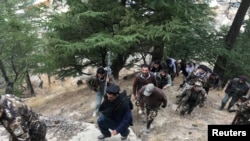Clerics and tribal leaders in an eastern Afghan province want authorities to rebuild and expand madrasahs, or religious schools, to prevent local youth from seeking Islamic education abroad.
They argue that more opportunities for religious education in the restive province of Nuristan would prevent youth from seeking the same in neighboring Pakistan, where some Afghan religious students are vulnerable to joining militant groups.
Mawlawi Karimullah, the leader of a tribal council in Parun, the provincial capital, says they want the authorities to swiftly build buildings for Darul Ulooms or houses of knowledge -- an Arabic word used as a formal name for Islamic seminaries.
“The government needs to immediately pay attention,” he told Radio Free Afghanistan. “If we have proper buildings, there can be hostels for poor students, which would help prevent them from going to Pakistan [to enroll at residential madrasahs].”
Mawlawi Zabihullah, a cleric in Parun, says providing Islamic education inside Afghanistan would give a new generation of clerics a sense of patriotism.
“Our next generation must be educated here so that they become patriotic and can love their country,” he said. “They are vulnerable to be manipulated into joining causes that ultimately result in the destruction of our homeland.”
The demand is rooted in Afghanistan’s recent violent history.
Since the 1980s, generations of Afghan clerics have flocked to madrasahs in Pakistan. Many joined the anti-Soviet mujahedin guerrillas in the 1980s, while the Taliban movement that emerged in the mid-1990s was mostly composed of students. The Taliban is a Pashto-language term for students of Islamic seminaries.
Many of the Taliban’s current and former leaders in Afghanistan were educated at the tens of thousands of madrasahs across Pakistan that typically offer free education and lodging to impoverished students.
In Pakistan, however, Islamist political leaders and rectors of major madrasahs reject imparting militant training and insist their only focus is to impart religious education.
In Nuristan, tribal leaders and clerics blame Pakistani madrasahs for indoctrinating Afghan students, which makes it easy for the Taliban and other militant groups to recruit them into jihad or Islamic holy war against their country’s government.
Karimullah says some 30 students from his village in Parun currently attend Pakistani madrasahs. “When they are educated in a foreign country, they are alienated from their homeland, and some even see their own people and country as foreign,” he said.
Most Islamist political parties and militant groups in Pakistan share the Afghan Taliban’s view that they are fighting against Afghanistan’s foreign occupation after a U.S.-led military intervention toppled their hard-line regime in late 2001.
“If our students can get Islamic education inside our country, they will not be exposed to this worldview,” he noted.
Authorities in Nuristan acknowledge that they have paid little attention to madrasahs in the province. Mawlawi Mohammad Amin Hamad, the provincial director of education, says some 5,252 students, including 2,000 girls, attend the existing 19 seminaries in the province.
“We have a great demand for quality religious education in this province,” he told Radio Free Afghanistan. “But many of our madrasahs lack buildings and facilities such as mosques, hostels, and toilets.”
Hamad says that more funds will help him meet these needs. Provincial Governor Hafiz Abdul Qayum says he is eager to help and has already asked the provincial education department and clerics to send him their plans. “I am waiting for their proposals and, god willing, we will address their problems,” he said.
Nuristan, a remote mountainous region, has been a hotbed of instability for decades. It borders northwestern Pakistan’s Chitral district to the east and is surrounded by the northeastern Afghan provinces of Badakhshan and Panjshir. It is more closely joined with the Kunar and Laghman provinces to the south.
The region became a center for the puritanical Salafi sect during the fight against the Soviet occupation in 1980s. Various militant groups fighting in the region were inspired by Salafi Islam. They kept the remote region largely free of a Soviet presence. During that period, Mawlawi Afzal, a local Salafi cleric and tribal leader, even claimed to have established an Islamist mini-state.
After the overthrow of the Taliban in 2001, Nuristan became a hotbed of insurgency. It turned into one of the most dangerous border provinces for international forces. Wanat, the site of a remote U.S. military outpost in Nuristan’s Waygal district, was the scene of a major battle in 2008.
Abubakar Siddique wrote this story base of Radio Free Afghanistan correspondent Rohullah Anwari’s reporting from Asadabad, Afghanistan.









